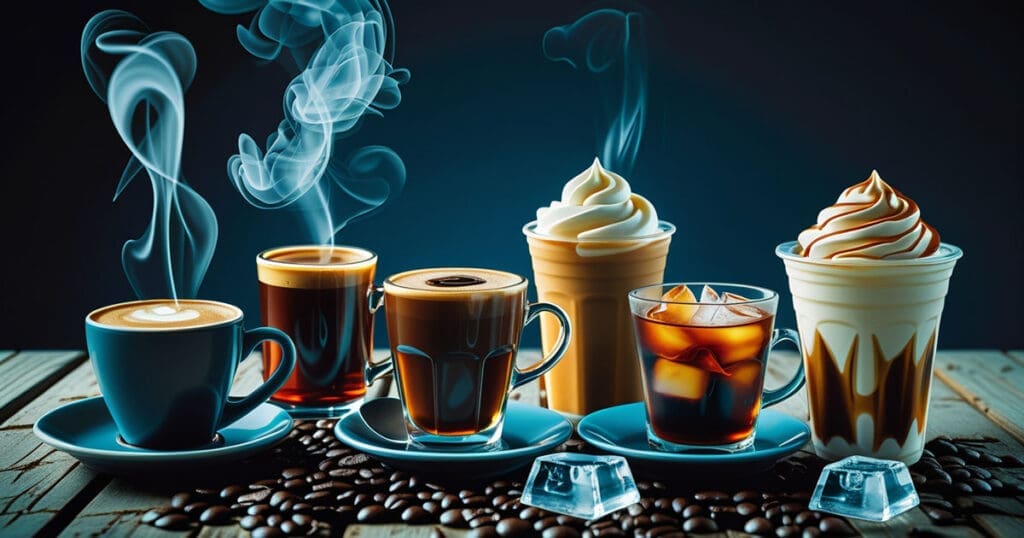As coffee lovers, we often look at the beans, brewing methods, and devices. But temperature is a key factor that's often missed. It greatly affects our coffee's taste.
Learning about temperature's role in coffee flavor can make our brews richer and more complex. This article will show how small changes in temperature can change our coffee experience. We'll look at brewing techniques and how temperature affects aroma.
Understanding Coffee Flavor Profiles
Exploring coffee reveals a world of unique flavors in every cup. We find tastes like fruity, nutty, and chocolatey. The temperature of our coffee greatly affects how we enjoy it.
The Basics of Coffee Flavor
Coffee's flavor is a mix of tastes and smells that make it enjoyable. Each cup can have different flavors based on where it's from, how it's made, and its temperature. Changing the brewing temperature can change how we taste our coffee.
Key Flavor Components
Many things make up coffee's flavor. Here are some important ones that temperature can change:
- Sweetness: Warmer temperatures can make some beans sweeter, making our coffee richer.
- Acidity: The acidity can change with the coffee's temperature, affecting how it tastes.
- Bitterness: Adjusting the temperature can also change the coffee's bitterness.
These elements work together to make coffee complex and enjoyable. Knowing how temperature affects these flavors helps us get the taste we want every time.
The Role of Brewing Temperature
Understanding brewing temperature is key to great-tasting coffee. The optimal coffee brewing temperature is between 195°F and 205°F. This range is crucial for getting the most flavor from the coffee grounds.
Optimal Brewing Ranges
Getting the brewing temperature right is important. Here are some key points:
- The best temperature for most brewing methods is 195°F to 205°F.
- Brewing too low can make the coffee taste weak and sour.
- Brewing too high can make it taste bitter and overpowering.
Temperature and Extraction Rates
Temperature affects how much flavor we get from coffee. Each part of the coffee reacts differently to heat. For example:
- Lower temperatures bring out acidic flavors first.
- Higher temperatures bring out oils and sugars, making the coffee richer.
- Finding the right balance lets us enjoy the coffee's unique flavors.
By focusing on brewing temperature, we can make our coffee experience better. This way, we can enjoy every sip fully.
How Temperature Influences Aroma
Understanding how temperature affects coffee aroma is key to enjoying it more. The science behind it is interesting. It shows how aromatic compounds are released when we brew coffee.
As temperatures go up, the coffee's fragrance increases. This makes our coffee experience more inviting for all.
The Science Behind Aroma Release
When we brew coffee, many aromatic compounds are released. These compounds change with temperature. Higher temperatures let more of these compounds escape into the air.
This results in a richer aroma. It changes how we experience our coffee. We see how temperature affects our enjoyment of each cup.
Aromatic Compounds Sensitivity
Everyone perceives aromas differently. This makes our coffee experiences unique. Some people might notice certain notes more than others.
This means small changes in temperature can change flavors and scents. By trying different temperatures, we can find flavors that suit our taste.
Cold Brew vs. Hot Brew: A Flavor Comparison
Exploring coffee, we often wonder how brewing methods change our favorite drink. A temperature experiment with coffee flavors shows us the differences between cold brew and hot brew. Each method brings out unique flavors, changing how we enjoy our coffee.
Flavor Differences in Brewing Methods
Cold brew gives us a smoother, less acidic coffee. It extracts flavors slowly, creating a mellow taste that might remind us of chocolate. On the other hand, hot brew brings out a variety of flavors quickly. This is because hot water extracts more aromatic compounds fast.
As we start our day, knowing how brewing temperatures affect flavor is key. It helps us appreciate the nuances of our morning coffee.
Accessibility of Cold Brew Flavors
Cold brew is great for exploring flavors. It lets us discover tastes that hot brew might miss. With a simple setup, we can try different coffee beans and blends.
This makes cold brew a thrilling choice for those eager to explore more coffee tastes. It opens up a world of flavors, enriching our coffee experience.
The Impact of Serving Temperature
Learning about serving temperature and coffee is fascinating. The perfect brewing temperature can change, but serving temps are key to flavor. Each coffee style has its best serving temperature, affecting how we taste it.
Ideal Serving Temperatures for Different Brews
Each coffee type likes a certain serving temperature. Here are some common ones and their ideal temps:
- Espresso: Best at 160-170°F, bringing out its bold flavors.
- Pour-over: Served at 130-145°F, letting flavors shine without too much heat.
- Café au Lait: Enjoyed at 140-155°F, blending coffee and milk perfectly.
- Iced Coffee: Chilled, between 40-50°F, for a refreshing taste without bitterness.
Taste Perception at Varying Temperatures
Temperature greatly affects how we taste coffee. Higher temps can highlight sweetness or acidity. Cooler temps soften flavors, making them easier to enjoy.
This shows how temperature changes coffee's taste. By drinking at the right temperature, we discover all the flavors in our coffee.
Temperature’s Effect on Acidity
Exploring coffee acidity levels helps us enjoy the bright, tangy tastes of quality coffee. When we make coffee, the brewing temperature affects how acidity levels show up. This connection makes our coffee tasting experience more exciting.
Understanding Coffee Acidity Levels
Coffee acidity greatly impacts its taste. Bright or tangy flavors come from certain acids in the beans. Things like where the beans come from, their type, and how they're processed all play a part. The brewing temperature is key in bringing out these flavors.
How Temperature Modifies Perceived Acidity
Looking into how temperature changes coffee flavor, we see hotter brews bring out acidic notes. Higher temperatures pull out more acidic compounds, making the coffee vibrant. On the other hand, cooler brews soften these sharp flavors, creating a smoother taste. This lets us adjust our brewing to match our taste preferences.
The Influence of Temperature on Bitterness
Learning how temperature changes bitterness helps us improve our coffee-making skills. Bitterness comes from compounds like caffeine and chlorogenic acid. These compounds react differently with heat during brewing.
The Chemistry of Bitterness
Higher brewing temperatures make bitter compounds more soluble. This leads to a stronger bitter taste that some find too much. The extraction process releases oils and acids, adding to the bitterness. This shows how temperature affects coffee's aroma and taste.
Temperature's Role in Modulating Bitterness
Lower temperatures can reduce coffee's bitterness. Adjusting our brewing methods shows how heat impacts flavor. Finding the right balance is key to enjoying the perfect bitterness.
By trying different temperatures, we can tailor our coffee to our liking. This makes our coffee experience even better.
How Cooling Changes Flavor
Have you ever noticed how coffee's taste changes as it cools? This change offers a peek into the world of coffee flavor modulation by temperature. It can make our coffee-tasting experience much better.
The Flavor Evolution in Cooling Coffee
When we first drink hot coffee, it tastes bold with bitterness and acidity. As it cools, these tastes change. The warm notes of a light roast might disappear, and flavors like caramel, chocolate, or fruit become clearer.
Trying a temperature experiment with coffee flavors lets us see this change. It shows how new tastes come out over time.
Temperature Drops and Flavor Release
Every degree drop in temperature changes coffee's chemical makeup, affecting its volatile compounds. These compounds are key to coffee's aromas and tastes. As coffee cools, more of these compounds are released, improving its flavor.
We can see these changes by just letting our coffee sit for a bit. Noticing these details can deepen our love for our favorite coffee.
The Science of Arrested Extraction
Exploring coffee leads us to arrested extraction. This method stops brewing by changing the temperature. It lets us control the flavor, making it just right for us.
What Is Arrested Extraction?
Arrested extraction pauses flavor extraction at a key moment. By adjusting the brewing temperature, we pick which flavors to keep and which to stop. This balance is crucial for the perfect taste.
Visualizing the Impact on Flavor
Let's see how temperature affects flavor. Imagine brewing coffee at different temperatures and stopping early. Each try gives a unique taste. This technique helps us find our favorite flavors, making coffee even more special.
Experimenting with Temperature in Home Brewing
Exploring the world of home brewing is exciting. Finding the right temperature for brewing coffee is key. It greatly affects the flavors we get from our beans. By experimenting with coffee flavors and temperature, we can see how much it changes our morning coffee.
Tips for Home Brewers
When brewing at home, being precise is important. To improve our brewing, here are some tips:
- Start with a range of temperatures. Try from 190°F to 205°F to find the perfect temperature for your beans.
- Keep notes during each brew. Recording flavor changes helps us find the best temperature.
- Adjust the grind size. Finer grinds need lower temperatures, while coarser grinds do better with higher temperatures.
Tools for Temperature Control
To improve our temperature experiments, we can use specific tools:
- Digital Thermometer: It's crucial for checking water temperature before brewing.
- Temperature-Controlled Kettles: These let us set and keep precise water temperatures.
- Smart Coffee Makers: Some models let us customize brewing temperatures for different flavors.
Using these tips and tools can boost our brewing skills. It leads to new and exciting flavors in every cup we make.
The Perfect Temperature for Different Coffee Types
Finding the right brewing temperature can make our coffee experience better. Different coffee types need specific temperatures to taste their best. Knowing how Coffee temperature impact works helps us brew better.
Specialty Coffees and Temperature Preferences
Specialty coffees need precise temperature control to show off their unique tastes. Single-origin coffees do well at lower temperatures, around 195°F to 205°F. This lets their delicate flavors shine without bitterness.
This temperature range is key to unlocking the fruity and floral notes in these high-quality beans.
Traditional vs. Modern Brewing Techniques
Traditional methods like French press prefer higher temperatures, about 200°F. This brings out strong flavors and a thicker body. Modern methods, like pour-over or cold brew, offer new ways to control temperature for better taste.
Exploring these different brewing styles shows how temperature affects flavor. It shapes our favorite coffee experiences.
Concluding Thoughts on Temperature and Flavor
Exploring how temperature affects coffee flavor has shown us a key link between brewing and taste. We've found that the right brewing temperature is crucial for the best flavor. Every detail, from brewing to serving temperature, impacts how we taste coffee.
Temperature can make or break different flavors in coffee. By changing how we brew, we can bring out more aromas and tastes. This makes our coffee experience richer and more enjoyable.
As we finish our talk, remember how temperature changes coffee's taste and feel. Cold brew and hot brew show the amazing range of flavors coffee can have. Each method brings its own unique taste, making coffee even more special.
We suggest trying different temperatures to find new coffee flavors. A cooler brew or adjusting the heat can reveal exciting tastes. Exploring these changes helps us love coffee even more and enjoy its many flavors.
Disclaimer:
Some of the links on this site are affiliate links, which means I may earn a small commission if you make a purchase through them, at no additional cost to you. Thank you for supporting Brew Sip Repeat!




Facebook Comments